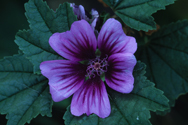 |
Mallows
Malva rotundifolia and Malva sylvestris
Family: Malvaceae
CTFA names: Malva Rotundafolia Flower, Malva Sylvestris Leaf Powder |
Return to herb list |

Photo © Steven Foster
Introduction
Malva rotundifolia (dwarf mallow) and M. sylvestris (high mallow) are both referred to as malva.1 Although they share many of the same properties,2 the mallows are considered inferior to the marshmallow (Althaea officinalis),a closely related genus.3 The dwarf mallow and high mallow are both native to Europe and Asia.3,4 Dwarf mallow grows and is cultivated extensively in Egypt and on the banks of the Nile4 while high mallow grows wild in the United States.5 Dwarf mallow has prostrate stems and pale lilac flowers.4 High mallow is a biennial, usually grown as an annual,5 stands erect, and grows to 3-4 feet,2,4 The heart-shaped leaves of the dwarf mallow and the stems and colorful bright flowers of the high mallow are used for medicinal purposes.4 History and Cultural Significance
Mallow was often called “cheese” by children who loved to eat mallow seeds because the unripe seed capsule had the shape of a round of cheese.2,6 It is thought that the Latin name, Malva, represents its soothing properties.7 Since Roman times, high mallow has been grown as a medicinal plant and potherb.3 Traditionally, high mallow was taken internally for bronchitis and bladder complications.8 However, high mallow was mainly used externally in forms of poultices (plant materials applied to the skin, usually in warm flannel) and fomentations (a hot, wet application)4 for itchy skin, eye irritation, and as a protective skin treatment for cracks, abrasions, chapping, and insect bites.9 In folk medicine, dwarf mallow leaves were used internally for colds, inflammation of the airways, and as a mild astringent.8 Externally, both mallows were used for wounds when applied as a poultice.6 Mallows are mucilaginous herbs (forming a thick, gummy liquid).2 Tea prepared from the leaf or root of dwarf mallow and high mallow helps sooth irritated membranes, especially of the digestive system.6 Mallow tea has been used to suppress cough, bronchitis, upset stomach, and inflammation.6 The thick gummy substance from the peeled root has been used to help relieve teething pain and constipation in children.10 The German Commission E approved both leaf and flower preparations of M. sylvestris as a tea or gargle for the relief of sore throat and dry cough.11 The French Explanatory Note of 1998 approved the use of the flower and leaf for symptomatic treatment of constipation.9 Modern Research
Currently, there are no studies available on the use of Malva rotundifolia (dwarf mallow) or M.sylvestris (high mallow). Future Outlook
Mallows are easily cultivated.5 Dwarf mallow is self-fertilized,4 and has been seen to produce normal mature plants from a single seed that had been dormant for more than a hundred years.12 High mallow colonizes roadsides in most of Europe, and its cultivated flowers can double or triple in size compared to that of the wild species.9 No information is currently available on the commercial cultivation of either mallow. References
1 Foster S, Hobbs C. A Field Guide to Western Medicinal Plants & Herbs. Boston, MA: Houghton Mifflin Company; 2002. 2 Felter HW, Lloyd JU. Althaea (U.S.P.)-Althaea. King’s American Dispensatory. 1898. Available at: http://www.ibiblio.org/hermed/eclectic/kings/althaea.html . Accessed on February 9, 2005. 3 Bown D. The Herb Society of America New Encyclopedia of Herbs & Their Uses. London: Dorling Kindersley Ltd.; 2001. 4 Grieve M. A Modern Herbal. Vol II. New York: Dover Publications, Inc.; 1971. 5 Bailey LH, Bailey EZ. Hortus Third: A Concise Dictionary of Plants Cultivated In the United States and Canada. New York: Collier Macmillan Publishers; 1976. 6 Foster S, Duke JA. A Field Guide to Medicinal Plants:Eastern and Central North America. Boston, MA: Houghton Mifflin Company; 1990. 7 Hyam R, Pankhurst R. Plants and Their Names: A Concise Dictionary. New York: Oxford University Press; 1995. 8 Jellin JM, Gregory PJ, Batz F, Hitchens K, et al. Pharmacists’s Letter/Prescriber’s Letter-Natural Medicines Comprehensive Database. 5th edition. Stockton, CA: Therapeutic Research Faculty; 2003. 9 Bruneton J. Pharmacognosy, Phytochemistry, Medicinal Plants. 2nd edition. London: Lavoisier Publishing; 1999. 10 Bartram T. Encyclopedia of Herbal Medicine. 1st ed. Christchurch, UK: Grace Publishers; 1995. 11 Blumenthal M, Busse WR, Goldberg A, Gruenwald J, Hall T, Riggins CW, Rister RS, editors. Klein S, Rister RS, translators. The Complete German Commission E MonographsūTherapeutic Guide to Herbal Medicines. Austin, TX: American Botanical Council; Boston: Integrative Medicine Communication; 1998. 12 Telewski FW, Zeevaart JAD. The 120-Yr Period for Dr. Beal’s Seed Viability Experiment. American Journal of Botany. 2002; 89(8):1285-1288.
|